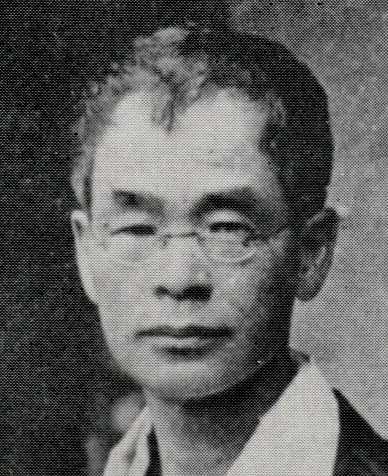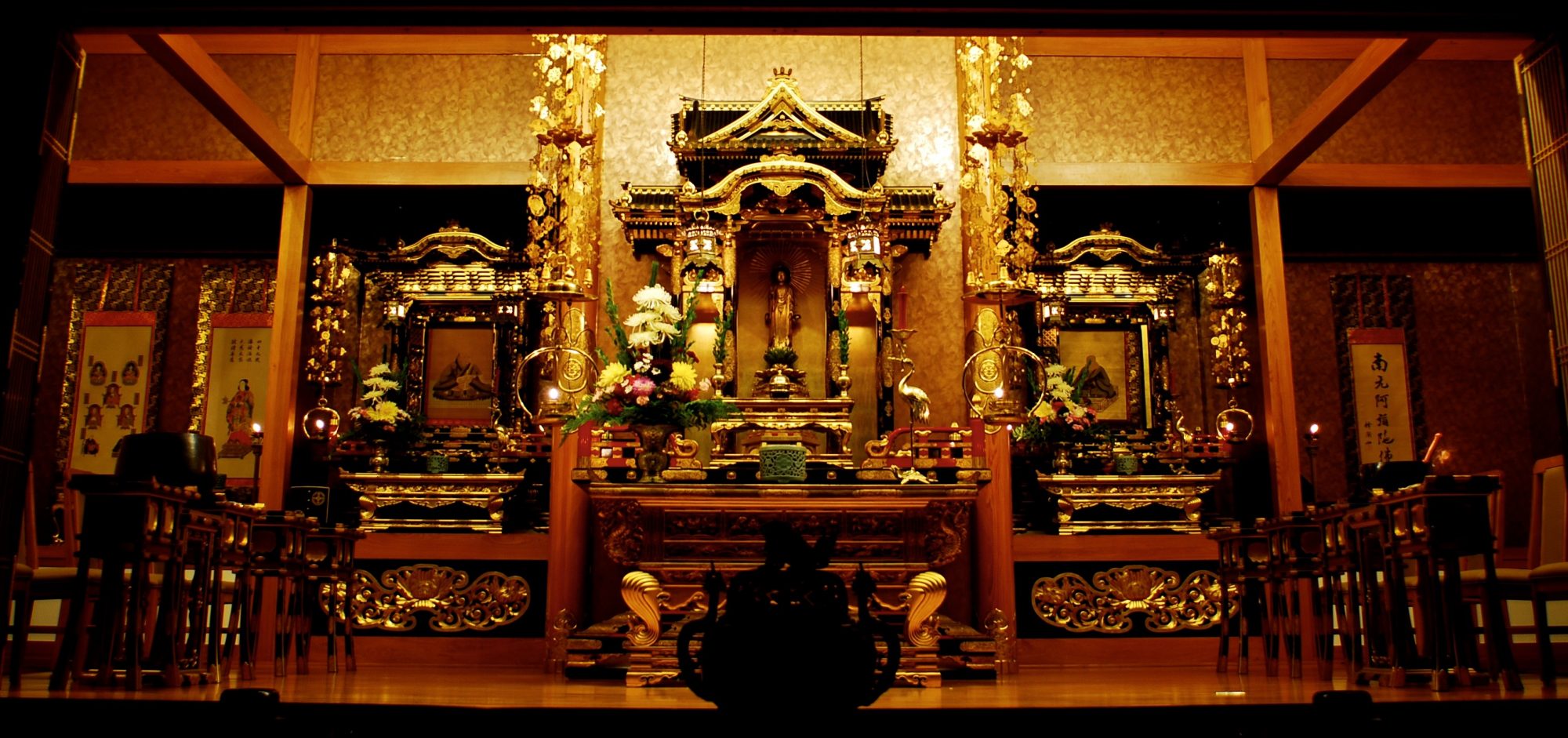
By Rev. Ken Yamada
Two of the most influential Buddhist thinkers in modern times led vastly different lives. Daisetz Teitarō Suzuki gained world-renown as a Zen expert, traveled widely, and lived to a ripe old age. Manshi Kiyozawa failed to reform institutional Jōdo Shinshū, died relatively young and unknown outside Japan. Yet, they have much in-common. Both clarified and explained Jōdo Shinshū in modern terms, albeit from different perspectives.
Suzuki, born in 1870—seven years after Kiyozawa—lived 95 years and died in 1966. Kiyozawa died in 1903 at age 39. They lived during a time when Japan was transforming into a capitalist society from feudalism as Western influence swept through the country.
“Kiyozawa Manshi and Suzuki Daisetz are two lofty peaks, rising high in the century-old history of the modernization of Japanese Buddhism,” wrote Hashimoto Mineo and Murakami Tatsuo in their essay, Two Models of the Modernization of Japanese Buddhism: Kiyozawa Manshi and D.T. Suzuki (The Eastern Buddhist, 2003, Vol. 35, No. 1/2)
Hashimoto wrote:
While this is a term with a variety of meanings, here it means to reform, strengthen and promote traditional or conventional Buddhism, by responding to and resisting the introduction of Western thought and civilization after the Meiji period. For that purpose, Buddhism first had to be equipped with logic and turned into an academic discipline, i.e., reconstructed into a coherent philosophical system. To put it simply, Buddhism had to be accepted by modern intellectuals first in order to have the possibility of shaking the foundation of their modernist consciousness. Although all religions consist of ideas (doctrines), actions (rituals), and community (religious organization), the modernization of Buddhism had to be started in the area of doctrine; in other words, the initial modernization of Buddhism was the active reconsideration of traditional Buddhist teachings.
While Suzuki gained fame as an authority on Zen, he produced works on Shin Buddhism throughout his life. For 20 years, he served as professor at Higashi Honganji’s Ōtani University, where he and wife Beatrice Lane Suzuki founded The Eastern Buddhist academic journal, publishing essays on Shin, Zen, and various Mahayana traditions.
“Suzuki, in joining various disciples at Ōtani, in fact shared many values with them—a modernist interpretation of Buddhism, an emphasis on personal religious experience, a commitment to learning, a respect for academic freedom, and a belief that institutional Buddhism must undergo reform,” Hashimoto and Murakami wrote.
Both Suzuki and Kiyozawa experienced personal spiritual awakening, but in two very different ways. Suzuki—absorbed in Zen practice from a young age—had a profound religious experience at age 26. Kiyozawa’s great realization came just before he died.
Suzuki’s early realization formed the basis of his interpretation of Buddhism for the rest of his life. Subsequently, he had to formulate the proper words, concepts and explanations—in other words a “philosophy”—to express what he experienced.
By contrast, Kiyozawa’s path was reverse. A highly conceptual and rational thinker, he first tussled with various philosophical perspectives—such as Kant, Hegel, Epictetus, the Agama Sutras, and Shinran—before grasping for himself religious understanding.
Hashimoto wrote:
In his experiment to modernize Buddhism, Kiyozawa approached Buddhism (religion) through the medium of the dialectic logic of Western philosophy. In other words, he moved from philosophy to religion. Suzuki on the other hand, tried to modernize Buddhism by moving from religion to philosophy. Through his Zen experience, he uncovered the logic of non-duality.
Suzuki viewed Jōdo Shinshū under the umbrella of Mahayana Buddhism, writing about elements and teachings in-common with Zen and Buddhism at large. This approach sometimes put him at odds with Kiyozawa’s spiritual successors, such as Soga Ryōjin (1881-1976).
James C. Dobbins, in his essay D.T. Suzuki and the Ōtani School of Seishinshugi (in the book Adding Flesh to Bones, Kiyozawa Manshi’s Seishinshugi in Modern Japanese Buddhist Thought, edited by Mark L. Blum and Michael Conway), described a 1958 dialogue between the two teachers as follows:
Suzuki attempted to frame the important themes of Shin Buddhism—Amida’s vow, birth in the Pure Land, other-power—in terms of the great motifs and doctrines of Mahayana: emptiness, the bodhisattva path, wisdom and compassion, ignorance, skillful means. But Soga characterized such treatment as overly logical and not satisfactory from a Shin point of view. He suggested that Suzuki’s approach would simply merge Shin with Zen without properly recognizing its distinctive character. Suzuki, in short, operated within a conventional framework of Buddhist studies, thinking across disparate texts and literatures and trying to make connections beyond confessional boundaries. Soga, by contrast, treated this approach as missing the meaning of Shin Buddhism and resisted any characterization that lacked an insider’s point of view.
However, Sasaki Gesshō (1875-1926), who became Ōtani University president in 1924, shared Suzuki’s perspective in explaining Shin Buddhism through the lens of general Buddhism.
Dobbins wrote:
In short, by researching Buddhism’s history and texts Sasaki sought to expand the range of meanings associated with Shin Buddhism and at the same time to validate Shin as standing squarely in Buddhism’s historical traditions. The key to this approach was to link personal religious experience in Shin to personal religious experience in all of Buddhism going back to Śākyamuni. This was a very different approach from traditional Shin dogmatics, which validated Shinran through the lineage of the Pure Land patriarchs. It is this very approach that Sasaki shared with Suzuki, providing a basis of their close scholarly, professional, and personal association.
Suzuki’s outlook sprung from his awakening experience. In his essay, D.T. Suzuki: A Brief Account of His Life (The Eastern Buddhist, Vol. 2 No. 2, 2022) Dobbins cites a letter he wrote, describing that moment at Engakuji temple, Kamakura, Japan:
Finally, during Engakuji’s December meditation retreat of 1896, more than a year after his planned departure and two months before his actual one, that long-anticipated awakening occurred. Suzuki’s account of it in a letter dated 1902 to his friend and former schoolmate, the philosopher Nishida Kitarō 西田幾多郎 (1870–1945), focused not so much on the dynamics of meditation and koan, but rather on an unexpected feeling that arose in him while walking in the moonlight from the meditation hall to his quarters in the Kigen’in 帰源院 hall that night: he suddenly lost any sense of difference between his own shadow and those of the trees all around, and he felt himself to be identical to them, and them to him.
This kind of “wordless” experience was intuitively felt, not explained and understood intellectually. Thereafter, Suzuki emphasized the importance of “intuition” and “feeling” over conceptual understanding.
In his book, Zen and Japanese Culture (Princeton University Press, Princeton, N.J. 1959) Suzuki explained how Asian culture placed great importance on intuition, whereas the West emphasized logic and reason. He wrote:
The principle of satori [spiritual awakening] is not to rely upon concepts in order to reach the truth of things, for concepts are useful in defining the truth of things but not in making us personally acquainted with it. Conceptual knowledge may make us wise in a way, but this is only superficial. It is not the living truth itself, and therefore there is no creativeness in it, being a mere accumulation of dead matter…
An intuitive mind has its weaknesses, it is true, but its strongest point is demonstrated when it deals with things most fundamental in life, that is, things related to religion, art, and metaphysics. And it is Zen that has particularly established this fact—in satori.
In a footnote, he wrote:
“Intuition” has various shades of meaning. Ontologically speaking, its most fundamental quality is to come directly in touch with Reality…
Recently, however, I have come to think that “feeling” is a better term than “intuition” for the experience Zen claims to have—“feeling” in its deepest, broadest, and most basic sense, and not the “feeling” psychologists generally distinguish from other activities of the mind. The experience the human mind has when it is identified with the totality of things or when the infinite becomes conscious of the infinite residing in it—this experience is the most primary feeling which lies at the basis of every form of psychic functioning we are capable of.
He cited poems by Bashō (644-1694) and Alfred Tennyson (1809-1892) to illustrate his point:
Yoku mireba. When closely inspected,
Nazuna hana saku. The nazuna is flowering
Kakine kana By the hedge.
(-Bashō)
Flower in the crannied wall,
I pluck you out of the crannies,
I hold you here, root and all, in my hand,
Little flower—but if I could understand
What you are, root and all, and all in all,
I should know what God and man is.
(Tennyson, “Flower in the Crannied Wall”)
In this example, Suzuki explained how Bashō grasped this unassuming flower’s beauty merely by observing it (i.e. intuition) , whereas Tennyson must tear out the poor flower to analyze it, in the process, destroying its beauty (i.e. intellectualization).
Of course, the conundrum Suzuki faced as a scholar was finding words and concepts to explain what he felt and understood intuitively, thus entering that realm of intellectualization he warned against. He spent the rest of his life writing and lecturing in just this way.
Perhaps that’s why Suzuki admired myōkōnin, unlettered commoners whose simple lives radiated a deep understanding of Shinshū teachings. He marveled that such “ignorant” people “can grasp the deepest possible meaning that even learned, scholarly, and acute-minded philosophers fail to grasp because it is too deep for their understanding.”
In the book, Buddha of Infinite Light, Suzuki said,
The problem of intellection is its inability to deal with ambiguity and contradiction, which take place in life all the time. In spite of such contradictions, the myokonin are thankful and joyful for what they have experienced.
When pride is gone, there is humility. And humility is recognition of Other-power. When humility is realized, we have a wonderful feeling of joy. Logically, humility should make one feel quite miserable. Yes, it does. But simultaneously one senses a feeling quite opposite to that of misery. In fact, there is joy and there is happiness.
Suzuki pointed to myōkōnin Saichi, who made wooden sandals for a living but wrote simple expressive poems, such as:
I don’t say any nembutsu.
It is not necessary.
Saved by the Buddha’s compassion,
how grateful I feel.
As for NAMU-AMIDA-BUTSU,
it is ever with me.
I am ever with it.
While asleep, NAMU-AMIDA-BUTSU.
While awake, NAMU-AMIDA-BUTSU.
While walking or resting,
while sitting or lying, NAMU-AMIDA-BUTSU.
While working, NAMU-AMIDA-BUTSU.
Suzuki explained Shinshū this way:
Silence is attained when the self is given up; when the self is given up, the consciousness of dualistic thoughts is altogether nullified; that is to say, no dualism exists.
When the Myōgō [Name] is pronounced and we are conscious of saying Namu to Amida, and when Amida is listening to us say Namu, there will be no identity, no silence. One is calling out to the other, and the other is looking down or looking up. There is dualism or disturbance, not silence.
But when Namu is Amida and Amida is Namu, when ki (ordinary beings) is hō (Amida Buddha or Dharma) and hō is ki, there is silence. That is, the Myōgō is absolutely identified with Amida. The Myōgō ceases to be the name of somebody who exists outside the one who pronounces the Myōgō. Then a perfect identity, or absolute identity, prevails, but this identity is not to be called “oneness.” When we say “one,” we are apt to interpret that one numerically, that is, as standing against two, three, four, and so on. But this oneness is absolute oneness, and absolute oneness goes beyond all measurement. In absolute oneness or identity, the Myōgō is Amida, Amida is the Myōgō. There is no separation between the two; there is a perfect or absolute identity of ki and hō.
This is when absolute faith is realized. This is the moment, as indicated by Shinran, that “Namu-amida-butsu” (Myōgō), pronounced once, is enough to save you. That “once,” an absolute once, is something utterly mysterious.
Despite culture and languages differences, Suzuki was especially adept at conveying Buddhist teachings in English. With a wide breadth of knowledge of Western culture and philosophy, he analyzed word usage and shades of meaning. He didn’t seem to hesitate meeting Westerners where they stood, at times, interspersing Christian terminology to make a point.
For instance, he once said, “God seems cruel to put us human beings into this world of birth and death, making us suffer so much. But nothing awakens religious consciousness like suffering.”
Suzuki’s wife Beatrice cared for litters of stray cats and dogs at their residence, perhaps that’s why he used an animal analogy to describe “Other Power,” likening it to a mother cat carrying her kittens from one place to another by taking hold of the neck of each kitten. No effort is required by the kitten.
In 1961 at age 90, Suzuki participated in a Shin Buddhism dialogue with Soga, Kaneko Daiei (1875-1971) and moderator Nishitani Keiji (1900-1990) (DIALOGUE: Shinran’s World, The Eastern Buddhist, Vol. 18, No 1, 1985). He explained the difficulty of translating Shinran’s works into English, using the term “hongan” [i.e. Amida Buddha’s primal vow] as an example:
“Hon” [in “hongan”] corresponds to pūrva and “gan” to pranidhāna, and the latter we translate into Japanese as “negai.” Negai expresses the feeling that one wishes to acquire something because it is lacking in oneself, or aspires to fulfill a wish not presently realized. In modern Japanese it is something like “kibō” “hope.” It is often translated into English as “desire” or “wish.” But these are not adequate, and “will” overemphasizes intent.
“Gan” of hongan is unlike any of these preceding terms. If Christian terminology were adopted, “prayer” would be the closest, but this word is so heavily laden with traditional Christian thought that it would take hundreds of years before it became properly Buddhist, that is, until it came to reflect the meaning of gan in its usage.
Ultimately, he said, “I have to make a choice, however tentative.”
In a lecture given in 1958 at New York Buddhist Church (published as a book, Buddha of Infinite Light, The Teachings of Shin Buddhism, The Japanese Way of Wisdom and Compassion, by D.T. Suzuki, The American Buddhist Academy, 1998), Suzuki returned to the idea of personal spiritual awakening transcending conceptual thought.
He said:
We sincerely pronounce the name of Amida, fully entrusting that his vow will enlighten us. To utter the name once with trustfulness and sincerity is enough, but generally we do not pronounce it sincerely. We may think that we are sincere and in possession of faith or belief in Amida, but real sincerity, real trust, is altogether devoid of such consciousness. As long as sincerity is conscious of itself, it is not genuine. So a sincere person does not say, “I am sincere.”
Such an attitude, however, may remain just a little bit, unnoticeably or insignificantly, in the depth of the unconscious; although the unconscious cannot be conscious, something of consciousness stays submerged there…
“Sincerity” is perfect forgetting of oneself, but at the same time not just forgetting. Religious or spiritual forgetfulness is something that one must experience personally for oneself. That is, one has to experience it personally to know what kind of forgetfulness or unconsciousness we are talking about.
Straying from the traditional view of Pure Land after-death, Suzuki emphasized spiritual awakening here and now. He said:
We find our inner self when NAMU-AMIDA-BUTSU is pronounced once and for all. My conclusion is that Amida is our inmost self, and when that inmost self is found, we are born in the Pure Land. The kind of Pure Land located elsewhere, besides where we are, is most undesirable. What is the use of lingering in the Pure Land, enjoying ourselves and doing nothing?
He said:
The Pure Land and Amida are revealed on this earth, though not as is taught by orthodox preachers. The Pure Land is not many millions and millions of miles away to the west. According to my explanation, the Pure Land is right here. Those who have eyes to see it can see it right here, even in this very hall. Amida is not presiding over a Pure Land beyond our reach. His Pure Land is this dirty earth itself. When I explain things in this way I am going directly against the traditional or conventional Pure Land doctrine.
This birth does not take place after what is called death. To sincere followers of the Pure Land, instead of being born in the Pure Land, the Pure Land itself is created or comes into existence when we sincerely pronounce Namu-amida-butsu. Therefore, instead of going over to the Pure Land, the Pure Land comes to us. In a way, we are carrying the Pure Land within us all along, and when we pronounce that magic formula Namu-amida-butsu, we become conscious of the presence of the Pure Land around us, or rather, in us.
Taitetsu Unno (1929-2014) in the introduction to Buddha of Infinite Light, wrote:
Since Suzuki didn’t come from the orthodox Shin tradition, his interpretation is not colored by sectarian dogma and sheds new light on its foundational experience…
When Suzuki speaks from the experiential standpoint about Amida, Pure Land, faith, and salvation, they take on a meaning that has universal implications. His subtle discussion of sincerity in religious practice and life is significant for both Buddhist and Christian spirituality. And his astute existential-psychological analysis of Shin faith underscores some shared commonalities with the Christian experience of grace.
Indeed, Suzuki sought common ground in which people of all types could find spirituality through their respective paths, which he showed in interpreting and explaining Jōdo Shinshū.
-Rev. Yamada is editor at Higashi Honganji’s Shinshu Center of America

